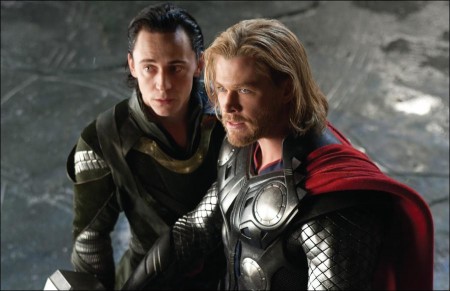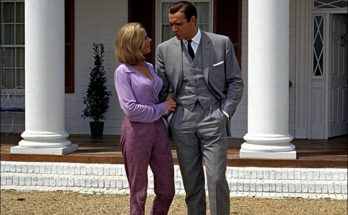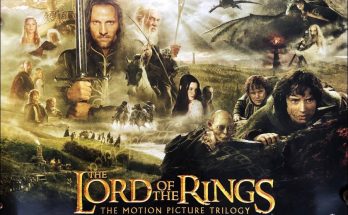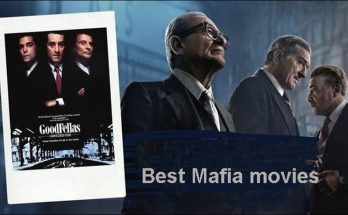Thor: The God / Man Who Fell To Earth. Principal photography for “Thor” began January 11, 2010 in Manhattan Beach with a huge fight sequence between the Asgardians and the Frost Giants. Thor shows how deadly he and his hammer can be, which gave Hemsworth the opportunity to show what he’d accomplished in four long months of training.
“You’ve got so much adrenaline running through you at the beginning of any shoot, and I think getting it out physically is the best remedy for that,” says Hemsworth (who’d exceeded expectations in his work-outs and had to shed some bulk in the final two weeks before filming began). “Running around in those big, heavy costumes, sweating, fighting, injuring ourselves—it shakes the cobwebs out.”
Hemsworth and stunt coordinator Andy Armstrong were inspired by Mike Tyson in determining Thor’s fighting style when he’s wielding Mjolnir. The choice was a great image for the young actor: “I’ve done a lot of boxing over the years and that made sense to me. We decided that’s how Thor would fight—a lot of shoulders and hips, big movements, a powerful stance, rooted into the ground.”
Mjolnir is a majestic implement, weighted with Odin’s portentous words: “WHOSOEVER HOLDS THIS HAMMER, IF HE BE WORTHY, SHALL POSSESS THE POWER OF THOR.” According to prop master Russell Bobbitt, nearly 200 drawings (in various shapes) were considered, and almost 14 weeks were spent getting the approved design to final form.
As with other design elements of “Thor,” the goal was to create something that looked right in today’s world, but emanated the flavor of Stan Lee and Jack Kirby’s original work. Bobbitt was also charged with creating signature weapons for Sif, the Warriors Three, Heimdall, Loki and, of course, Odin. Lighter-weight rubber versions of these weapons were made for stunt sequences.
The hero version of Odin’s shape-shifting spear, Gungnir, was made of solid brass, carved with designs that included a representation of Yggdrasil, the ancient tree that unites the nine realms—in its final form, it weighed in at 30 pounds.
“Anthony Hopkins carried the 30-pound brass Gungnir every single day of filming,” tells Bobbitt. “I gave him a lighter one a couple times, when I thought he might want it, but he’d always hand it back and say, ‘Russell, give me the real one.’”
One doesn’t refuse Odin.
When Mjolnir crashes to earth, it creates a giant crater outside Puente Antiguo. SHIELD agents lock down the site with a warren of tubular tunnels, where Thor fights another pitched battle, this one, a bare-knuckles brawl. Hemsworth recounts, “Andy and the stunt guys said, ‘Okay, you’ll come in here, throw a punch, kick him.’ I said, ‘Do we rehearse?’ They said, ‘No, let’s just shoot it.’ The idea was to keep it rough and real and messy, not a staged kung fu fight. It was a hell of a lot of fun.”
Far less fun—as the hero is fighting not only for his own life, but for the lives of his friends who have gathered to help defend him—is the enormous showdown between Thor and the Destroyer, which unfolds on the streets of the now-in-ruins Puente Antiguo.
“When we were discussing that fight, we got giddy like kids,” says Hemsworth. “It was a nice top-off to all the fight sequences, and pretty evenly matched between the toughest guy and the baddest guy.”
Second-unit director Vic Armstrong and his team had blown up most of the town a few days earlier, and the once-tidy streets were littered with burning embers and broken glass. A nine-foot stationary Destroyer was hunkered down in the middle of the road, its movements to be articulated in post-production by Wesley Sewell’s visual effects team. On set, Branagh and first assistant director Luc Etienne vividly narrated the mayhem for Hemsworth and his fellow Asgardian warriors, as they took turns trying to neutralize their impervious foe.
The Destroyer was in Odin’s service for many years, to deter any threats to the fragile peace that prevailed. But at this point in the story, it is quite clear that someone else is controlling it and its unbeatable weaponry.
“The name says so much,” Branagh says. “It’s a soulless piece of violent, destructive, wreckage-making power, an empty suit of armor embodied by the person who is in control of it at that moment. It makes a huge, powerful appearance in our film – you must watch to see what happens!”
* * *
Indeed, there are many surprising elements to “Thor,” not the least of which is a cast that includes Academy Award® winners sprinkled among the accomplished veterans and a plethora of up-and-comers. The list of crew reads like a ‘who’s who’ among lauded motion picture artisans.
To see such a high-profile, high-octane project helmed by a famed interpreter of William Shakespeare, might surprise the fans of the Superhero genre. And yet, quite possibly, the person least surprised by his involvement is Branagh himself. Kenneth Branagh closes, “It’s got everything that I love.
A hero who is a reckless, headstrong young man who has to confront his past and deal with a complicated relationship with his father. There are a lot of savage Europeans hacking each other to death at various points and actually, it sounds very much like ‘Henry V’ to me. ‘I’ve been down this road before…’ So, you could say that I started in super hero films – the only difference in my previous ones, is that people talk funny!”
Visits: 93



